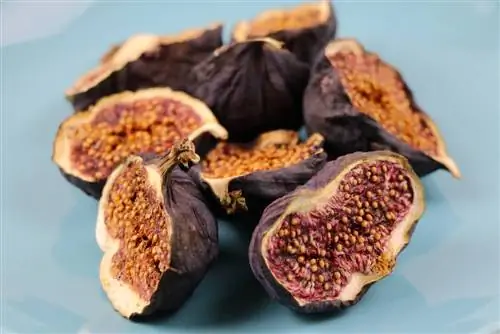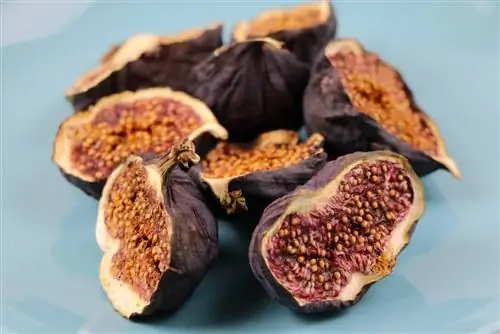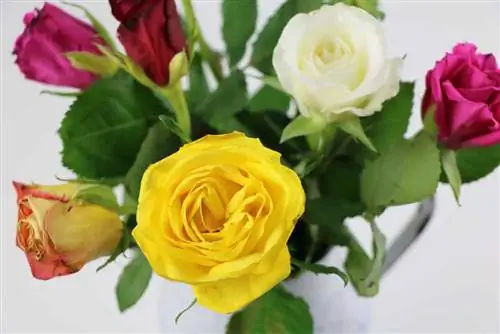- Author admin [email protected].
- Public 2023-12-17 03:39.
- Last modified 2025-06-01 06:48.
If you grow figs yourself and can't use them all fresh, you can turn them into a sweet and long-lasting dried fruit by drying them. However, in order for the preservation to be successful, a few factors must be taken into account. Otherwise the figs could become moldy or attacked by insects. Whether you choose the sun, oven or microwave - in any case it is important to have some patience. Because drying the figs takes some time.
Drying
Figs are he althy fruits that are rich in minerals and fiber. This is especially true for dried figs, as they have a higher density of nutrients per gram due to their low water content. They also last longer when dried, meaning larger yields can be used over months than dried fruits. If there are leftover figs that cannot be eaten fresh, drying them makes a lot of sense. However, it is important to adhere to a few basic rules.
Basic rules
So that the figs are really durable and do not become affected by mold, they must be dried properly. Following the following basic rules can help extend the shelf life as desired:
- plan enough time - drying in the oven and the sun takes several hours or even several days
- Turn often - even if the figs are on a rack or grid, they should be turned regularly to ensure even drying
- Control - dried figs are leathery and can only be bent slightly before they break
- all-round protection - when drying in the sun, the figs need protection from insects and in the oven from burning
- Ensure moisture extraction - drying removes liquid from the figs, which must be able to escape unhindered
Depending on the type of drying you choose, the implementation of the basic rules can differ slightly.
Sun
Natural, energy-saving and without the risk of fire - drying in the sun is particularly easy and inexpensive, but takes several days. There is also a risk that the figs will be attacked by insects. Therefore, appropriate protection should be placed around the fruits. A close-meshed insect protection net that is hung over the figs and closed underneath them is suitable for this. Alternatively, drying in the sun can also be done behind a window that has a fly screen. If such protection can be provided, the following procedure will be followed:
- The figs are washed and patted dry.
- The figs are lined up on a grid or rack at least two fingers wide apart.
- Grids or grate are positioned in an airy place in the blazing sun. The air should also be able to circulate well from below. It is therefore recommended to place the grid on four blocks or upside down flower pots, for example.
- The figs are turned after five hours in the sun. It is enough to turn them once or twice a day.
- The figs should only be left outdoors if the temperature is at least 20°C at night.
- Checks should be carried out daily in order to be able to remove affected fruits in the event of mold infestation.
It takes at least two to three days to dry in the sun, but usually a little longer. When the humidity is high, drying takes more time. If it rains, the fruits must of course be brought indoors.
Oven
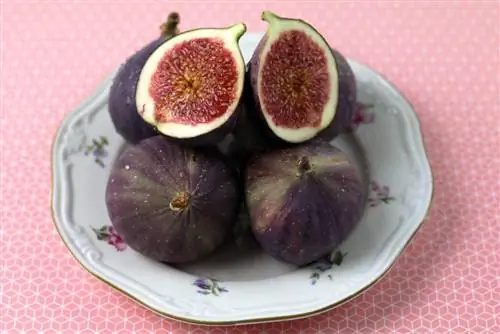
Drying in the oven is possible, but it also takes some time. The following points are important for this variant of drying:
- Wash the figs and pat dry thoroughly.
- The fruits can be whole, halved, quartered or even sliced. The smaller the pieces, the faster the figs will dry.
- The figs are placed on the grate. It is not necessary or sensible to put baking paper underneath the whole fruit, but it does provide protection for the oven and the fruit when it comes to slices, quarters or halves.
- The figs are now dried at 50 to a maximum of 60°C and ideally with circulating air. To ensure that any escaping moisture can be removed, the oven should be left slightly open. It makes sense to clamp a wooden spoon between the oven and the door.
- The fruits are turned about every two hours.
For whole fruits, drying in the oven can take up to 36 hours, depending on the liquid content of the figs. The smaller the pieces or slices are, the less time you have to plan for it. For thin slices, two to four hours can be enough. It is also important that the temperature does not exceed 60°C in order to really dry the figs and not bake them.
Microwave
It sounds tempting to turn the figs into dried fruit in a short time in the microwave. However, there are two limitations here. On the one hand, the figs are not actually dried, but are first cooked and then dried out. On the other hand, the high temperatures in the microwave cause valuable vitamins to be lost to a greater extent than is the case in the sun or the oven. If you want to get as many nutrients as possible, you should avoid using the microwave. In addition, only small amounts of fruit can be dried in the microwave. In comparison, however, it is the most time-saving method of drying.
The procedure is as follows:
- The figs are washed and dried and at least cut. Otherwise there is a risk that they will “explode” due to the boiling juices. Halving, quartering or cutting into slices is of course also possible and in turn shortens the duration of drying.
- Placed on a plate, the figs are first heated in the microwave for about two minutes at the highest power. This causes large amounts of moisture to escape, which is why the microwave must then be ventilated well. It also helps to wipe the device.
- With the microwave at the lowest power, the figs are now dried for a total of about 20 minutes. Whole fruit may require double the time. For thin slices, correspondingly less.
- Every two to five minutes at the latest, you should check again, ventilate the microwave and wipe out any liquid.
Tip:
Carefully turning the figs and dabbing the plate ensures that the fruit does not stick to the surface and also promotes drying.
Alternatives
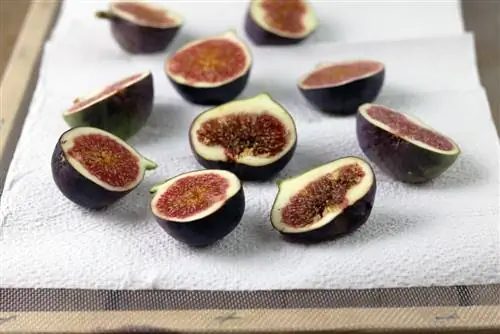
An alternative to the oven, sun and microwave is a dehydrator that automatically regulates ventilation, moisture removal and constant temperature. If this purchase is not worth it because drying is done very rarely, the methods can also be combined with each other. This means that figs that have been pre-dried in the sun can be finished drying in the oven. Fruits that have been dried in the oven for a few hours can also be air-dried if the weather is sufficiently warm and dry. On the one hand, this combination allows you to save a lot of energy. On the other hand, very large quantities of figs can be dried in layers, so to speak.
Tip:
Other alternatives to drying figs include freezing and preserving. They can also be preserved in these ways.
Storage
Whatever you choose when drying, it is important that the fruit cools down sufficiently before storing. They should also be stored in an airtight container, dark and cool. For example, a mason jar or a jar with a screw cap in the refrigerator is ideal. It is also important that the fruits are checked every now and then. If there is condensation inside the glass, if they change color or have an unpleasant smell, they still contained too much moisture or were contaminated and are therefore no longer suitable for consumption.
Conclusion
Drying figs is easy in itself, but it requires a bit of effort and, above all, a lot of patience. However, it is an easy method to preserve larger quantities of fruit and is possible with just a little space in the sun, a microwave or an oven.

